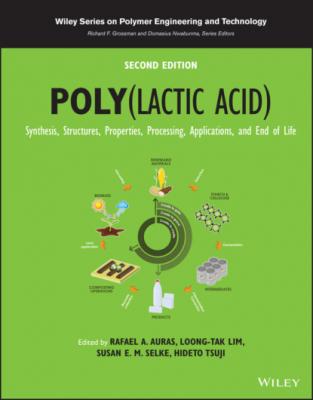Poly(lactic acid). Группа авторов
Читать онлайн.| Название | Poly(lactic acid) |
|---|---|
| Автор произведения | Группа авторов |
| Жанр | Химия |
| Серия | |
| Издательство | Химия |
| Год выпуска | 0 |
| isbn | 9781119767466 |
FIGURE 5.4 Schematic representation of the methods adopted for developing sb‐PLA.
5.5 STEREOCOMPLEXATION IN COPOLYMERS
The formation of sc‐PLA has been studied with various copolymers of enantiomeric PLAs with other well‐known bio‐based/biodegradable polymers such as PCL, PEG, and so on due to the complementary properties of the counterparts, which may lead to materials with customized properties. The mechanical and thermal properties of representative bio‐based/biodegradable polymers used for copolymerization are summarized in Table 5.2.
5.5.1 Stereocomplexation in Random and Alternating Lactic Acid or Lactide‐Based Polymers
Stereocomplex crystallites can be formed only by the interaction of enantiomeric PLA chains (PLLA and PDLA), which can be controlled during melt processing. Further, sc‐PLA has a limited ability to reform its crystallinity after being melted (removal of thermal history). To improve the molecular interaction between PLLA and PDLA, Purnama et al. have studied stereocomplexation in the blend of PLLA and random copolymer (PDLCL) of D‐lactide with small amount of caprolactone (CL) [66]. The small amount of CL units in PDLCL act as soft fraction (due to the presence of methylene linkage) in the polymeric system to provide relatively low glass transition and melting temperatures. Further, this soft fraction accelerates the PDLA chain movement to easily interact with PLLA chains, thereby resulting in improved melt stability of sc crystallites. They also reported that the system resulted in the maximum sc crystallinity when the amount of CL was 2.5 unit‐mol%. It was however indicated that the excess use of CL may lead to overactive mobility of PDLA chains, ultimately affecting the stereocomplexation. In an another approach, Jikei et al. attempted to develop a segmented, random multiblock copolymer of PLLA and PCL and blended it with PDLA to improve the stereocomplexation [67]. The soft segment PCL aided in improving the elongation at break (over 400%) of PLLA, whereas preferential formation of stereocomplex crystallites in hard domain (containing PLLA and PDLA) contributed to enhancing the Young’s modulus (over 400 MPa) and ultimately improved the overall toughness of the blend. In particular, the physical crosslinking in hard domain also contributed to enhance the thermal deformation stability of the blend.
TABLE 5.2 Mechanical and Thermal Properties of the Representative Bio‐Based/Bio‐Degradable Polymers
| PLLA | sc‐PLA | PGA | PHB | PCL | |
|---|---|---|---|---|---|
| T m (°C) | 170–190 | 220–240 | 225–230 | 188–197 | 55–65 |
| T g (°C) | 50–65 | 65–72 | 40 | 5 | −60 |
| ΔH m (J/g) | 93–203 | 142–155 | 180–207 | 146 | 136 |
| Density (g/cm3) | 1.25–1.3 | 1.21–1.342 | 1.50–1.69 | 1.18–1.26 | 1.1–1.15 |
| Tensile strength (MPa) | 120–2260 | 880 | 80–980 | 180–200 | 8–16 |
| Young’s modulus (GPa) | 6.9–9.8 | 8.6 | 3.9–1.4 | 4.9–5.9 | 0.1–0.4 |
| Elongation at break (%) | 12–16 | 30 | 30–40 | 50–70 | 100–2000 |
Furthermore, stereocomplexation involving alternating copolymers comprising lactic acid (LA) units have been studied extensively. For example, blending of enantiomeric alternating copolymer of LA and glycolic acid (GA) having molecular weight of 5000 Da leads to preferential formation of stereocomplex crystallites as reported by Tsuji et al. [68]. They proposed that blending of alternating LA‐based copolymers could be a versatile technique for the development of high‐performance bio‐based biodegradable materials with tunable physical properties and biodegradability. Yet another study reports the incorporation of alanine unit into LA units in random copoly(ester‐amides) with ester and amide linkages leading to the preferential formation of sc crystallites [69]. However, the developed polymers contain low degree of polymerization, and to have them employed in the commercial scale utility, further development is needed.
5.5.2 sc‐PLA–PCL Copolymers
Lately, there have been important advances in sc blends of PLA copolymers for biomedical implant applications. In a study reported by us [70], diblock copolymers of PCL‐PLLA and PCL‐PDLA were synthesized by two‐step ROP followed by blending them in a 1 : 1 ratio to achieve sc blends of the enantiomeric diblock copolymers. Using this strategy, it was possible to obtain enantiomeric diblock copolymers having enhanced mechanical properties (28 MPa strength and ~80% elongation at break), which were also processed by the conventional injection moulding technique to develop cancellous bone screws (orthopedic implants). The study reported the thermomechanical stability of the cancellous bone screw at 121°C in comparison to commercial PLA (2003D, NatureWorks LLC). The stereococomplexed diblock copolymer was found to be stable at the sterilization temperature of biomedical devices, unlike the commercial PLA sample. The biocompatibility of the synthesized sc diblock copolymer blend was also ascertained by MTT (3‐(4,5‐dimethylthiazol‐2‐yl)‐2,5‐diphenyl
